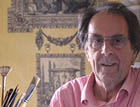Doing up your dream house: Decorative painter
Our new series, Trade Secrets, begins with a profile of John Sutcliffe, Decorative Painter by trade.


Everything is possible with paint. So many of the best restorations of country houses in recent years have made good use of the kind of decorative treatments so beloved of the 18th and 19th centuries, including marbling and graining. One of the champions of this art based as much on his understanding of architectural history, as his ability to wield a brush is John Sutcliffe. He lives in Cambridge, but has worked throughout the UK, Europe and the United States. A former National Trust curator, he was encouraged by John Fowler to get more involved in the practical side of decorating houses, and in 1973, he swapped his desk for a ladder. His first proper commission was to restore the Chinese wallpaper at Felbrigg. Since then, he has re-created many historic painted finishes, but more than half of his work involves designing new schemes using traditional techniques. Mr Sutcliffe says: 'Many jobs combine an element of the two historic hand painted Chinese wallpapers, for instance, have no repeat. When a section needs to be re-created, it must be designed anew'. Mr Sutcliffe does a lot of graining, particularly for the National Trust, such as at Wimpole, where he has reinstated part of a faux granite scheme in a Soane-designed bathroom. He uses water-based paints mixed to a Victorian recipe that includes beer. For marbling, watercolours and oils are used. 'Marbling tends to be subdued, and often used for a fireplace surround or dado, although I have marbled whole rooms, such as a black marbled dining room in London.' Mr Sutcliffe's work ranges from the plainest painted or lime washed walls, to the finest decorative finishes and ornaments for print rooms. He is also skilled in mixing colours, based on visual, rather than scientific, paint scrapes. 'Last week, I discovered that the inside of Churchill's croquet hut at Chartwell was a greeny eau de nil rather brighter than expected.' John Sutcliffe: 01223 315858 TOP TIPS
- Before deciding on a finish, have large samples made up; the bigger the sample, the better the idea of the end result.
- Be brave about colour?do not shy away from using unusual or bright colours, but always execute a large sample and then stand well back to observe the colour.
- The happiest results are always achieved through a sustained dialogue between the painter and the client. Exchange ideas and talk them through before making a decision.
Exquisite houses, the beauty of Nature, and how to get the most from your life, straight to your inbox.
Country Life is unlike any other magazine: the only glossy weekly on the newsstand and the only magazine that has been guest-edited by His Majesty The King not once, but twice. It is a celebration of modern rural life and all its diverse joys and pleasures — that was first published in Queen Victoria's Diamond Jubilee year. Our eclectic mixture of witty and informative content — from the most up-to-date property news and commentary and a coveted glimpse inside some of the UK's best houses and gardens, to gardening, the arts and interior design, written by experts in their field — still cannot be found in print or online, anywhere else.

